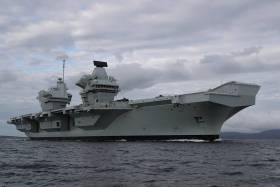Displaying items by tag: HMS Queen Elizabeth
Royal Navy Blames Propeller Issues for Flagship’s Withdrawal From Historic NATO Drill
The UK’s Royal Navy has withdrawn its fleet flagship from a historic NATO exercise on Norway’s Arctic coast over what it says are issues with the vessel’s propeller.
According to Marine Industry News, the HMS Queen Elizabeth had been due to sail from Portsmouth on Sunday evening (4 February) until routine checks identified an issue with a coupling on the vessel’s starboard propeller shaft.
The £3.5bn, 65,000-ton aircraft carrier — which has parts constructed in the same shipyard that built the Naval Service’s LÉ George Bernard Shaw — will be replaced by sister ship HMS Prince of Wales in exercise Steadfast Defender 2024.
The Prince of Wales has had its own share of propeller issues, previously breaking down shortly after setting out for the United States on deployment in August 2022.
Steadfast Defender 2024 is NATO’s largest exercise since the end of the Cold War, involving some 90,000 military personnel from all NATO members and Sweden.
Marine Industry News has more on the story HERE.
Shipyard Where LÉ George Bernard Shaw Is Under Construction Contributed to Building UK's Royal Navy's Largest Ship to be Commissioned Today
#GBShaw/QE – The shipyard currently constructing an Irish Naval Service OPV, also contributed in building the UK’s Royal Navy’s largest warship, HMS Queen Elizabeth, an aircraft carrier that is to be commissioned into service at 12 noon today, writes Jehan Ashmore.
The Naval Service's fourth OPV90 class newbuild to be named LÉ George Bernard Shaw costing €67m is been built at Babcock Marine & Technology’s yard in Appledore, north Devon. The OPV is scheduled to enter service in 2019. The same shipyard also constructed modular sections as part of six UK shipyards involved in the Aircraft Carrier Alliance (ACA) that were assembled in Babcock's yard in Rosyth, Scotland where the giant 65,000 tonnes flagship aircraft carrier was completed earlier this year. The vessel is the largest ever surface warship in the Royal Navy's history.
In Portsmouth Naval Dockyard Base today is where the commissioning ceremony will be attended by Queen Elizabeth II. A live televised broadcast begins at 12 noon today on BBC Newsroom Live (BBC News Channel and BBC2).
Last month Afloat monitored the HMS Queen Elizabeth that has a crew of 700, conduct trials in the Bristol Channel while off the north Devon coast. The overall crew complement total will more than double when aircraft personnel join from fighter jets and helicopters.
The leadship is the first of a pair of QEII class aircraft carriers in which the second newbuild, HMS Prince of Wales is under construction also in Rosyth. There has been criticism of the £6.2 billion cost overruns for both carriers and in the delay of F-35 aircraft jets from US manufacturers. The HMS Queen Elizabeth due to training reasons will not be fully operational until 2021 and as for the sistership this will be in 2023.
Another connection with Scottish shipbuilding but not on the Fife was the launch last month on the Clyde of the Glen Sannox, the first of a pair of ‘Green’ hybrid sister car-ferries for operator CalMac. They are the world’s first liquified gas duel (LNG) marine diesel fuelled ferries. Glen Sannox was scheduled to enter service on the busy Ardrossan-Brodrick, Isle of Arran route (see voyage report) in summer 2018.
The second sister is due to run on the Skye to Harris route, however last month according to The Herald, the newbuilds are experiencing technical issues at Fergusan Marine Engineering Ltd and are now not expected to enter service until 2019 or even 2020.
The FMEL shipyard at Port Glasgow, which was saved from closing in recent years is undergoing a £12m redevelopment on the banks of the Clyde.
























































